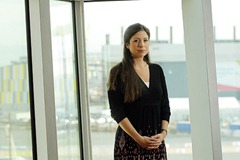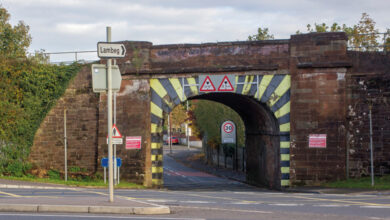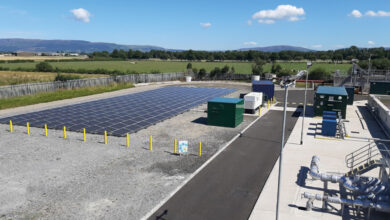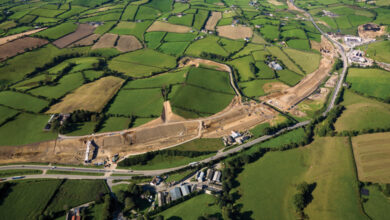Claire Haggett: listening and the social acceptance of renewables
 Taking the time and effort to genuinely listen to communities is the key to making wind farms socially acceptable, sociologist Claire Haggett contends. She talks to agendaNi about why the term ‘NIMBY’ does not reflect actual reasons for opposition.
Taking the time and effort to genuinely listen to communities is the key to making wind farms socially acceptable, sociologist Claire Haggett contends. She talks to agendaNi about why the term ‘NIMBY’ does not reflect actual reasons for opposition.
Wind farm developers often see local opponents as opportunistic and uneducated, with a not-in-my-backyard (NIMBY) mentality. However in most cases, objections are based on rational grounds and understanding those reasons can pave the way for an acceptable development.
That is the case made by Dr Claire Haggett, a University of Edinburgh sociologist who lectures on sustainable development and has considered 20 years of research into the social acceptance of renewable energy.
“Wind is so visible so there’s very often very little way to try and hide a wind farm,” she comments. “Perhaps more important than that is that wind came first, that it was the first market-ready technology, and I think there were some unavoidable and perhaps understandable mistakes that were made in the development and deployment of wind.”
Some early wind farms were noisy (compared to later developments) or built too near centres of population or in areas of outstanding natural beauty. These examples have therefore created a “very difficult context” for subsequent wind farm construction.
Developers and regulators “understandably assumed that people would support renewable energy” but those assumptions irritated residents living near potential sites who felt “that perhaps they weren’t being listened to.”
Haggett adds: “There are some fantastic developers engaged in brilliant work with local communities, really trying to listen to what people say, but unfortunately there are some who aren’t quite so good.” She finds that residents want to support wind farms but have real concerns that the development will affect their livelihoods or have other negative consequences upon their lives.
Speaking at the Northern Ireland Offshore Renewables Seminar, Haggett noted that wind farms tend to generate negative (and often unfair) campaigning and publicity which is nevertheless effective. A 2005 study by David Toke, a senior energy policy lecturer at the University of Birmingham, found that local opposition was the key factor for wind farms being rejected.
“We need to try and understand, not just dismiss, what people are saying,” Haggett advised. The term NIMBY, always an insult, obscures the reasons why people protest, devalues their concerns and does not take into account objectors who do not live near the wind farm.
Instead, she thinks that it is more accurate to say: “People are actually in support of renewables and they’re even in support of wind farms being near them but there’s something about that wind farm, something about that application, that qualifies that support, that turns them against it.”
Qualified support
Local people may consider their landscape to be too rare or valuable for a wind farm and therefore object to the number, layout or shape of turbines. This helps to explain the rejection of a wind farm for Auchencorth Moss, in Midlothian; the site contains one of Scotland’s few remaining raised peat bogs and is one of the few areas in the UK that is considered totally unspoilt.
In terms of social context, developers should not assume that all communities will be the same. One community may be in favour and another against or two communities may be opposed, for two different reasons. Local politics, the make-up of the community and local economic or social history are all critical in how people will view an application.
Patrick Devine-Wright, a professor of human geography at Exeter University, has researched this sense of ‘place attachment’ in Teesside where a local group opposing an offshore wind farm describes it as a “hazardous industry”. While this appears surprising, residents view the established petro-chemical industries as part of area’s “economic life-blood” while the wind farm is seen as intruding, with no benefit for the community. In such an area, Haggett suggested: “Perhaps even looking out to sea is the one decent view you have left.”
People naturally tend to engage with the immediate and things that are actually going to affect them. Most people do care about climate change and global warming but those problems do not yet impact on their day-to-day lives. The proportional reduction in CO2 emissions by being near a wind farm is “a very small and intangible benefit.” This can be summed up as a ‘local-global disjuncture’.
Residents may also feel that outsiders are coming into the community while local people have no say in the process. Attempts to educate residents about climate change and the need for renewables “very often fall on deaf ears” when they feel that a developer is just interested in money.
If people only have an opportunity to have their say after a plan is unveiled, they have no choice but to protest. In one case in North East England, opponents were worried that a wind farm would become an added distraction at an accident black spot. They would, though, have been supportive if the site had been further back from the road.
Offshore wind energy is often seen as a solution, as the turbines are far removed from a population, but the development is still visible from the shore and affects tourism, shipping and fishing interests.
Consultation exercises, in her view, should be judged on whether any action will be taken on the information received. Research by Australian environmental scientist Catherine Gross suggests that “if people feel that the process has been fair, they’re more likely to support the outcome of it.”
In summary, Haggett’s main message to developers is to listen to people and “really try and get people to understand that you are listening.” Engaging with the public can be a very difficult, time-consuming and costly process but she adds: “I think that all of that time and energy is worth investing.”
Handling objections
| Reason | Potential way forward |
| Rare or valuable landscape | Create open days or use the site as a tourist attraction (e.g. for walking) |
| Local context | Find out about the factors, capitalise on them (e.g. mining gives an area a narrative about energy) and find trusted local champions |
| Local-global disjuncture | Create immediate tangible benefits (e.g. by distributing energy-saving light bulbs) |
| The developer | Early, open, continual consultation and engagement |
| Residents have no say | Talk to them, listen to them and take action if possible |





